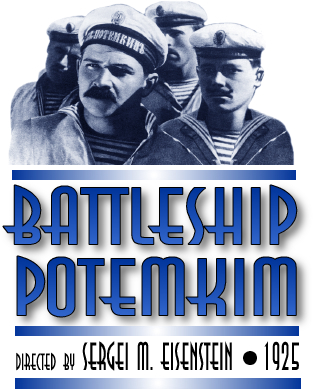

A brief description of the qualities of "Potemkin," together with a summary of expert opinion regarding the film, is best furnished by the following quotations . . .
Paul Rotha, in "Movie Parade," wrote . . .
. . . in the third great epic film if cinema, 'Potemkin,' Eisenstein
used the movements of the mass to interpret the events which expressed
his theme.
V.I. Pudovkin, in "Film Technique," refers to
. . .
. . . that filmically outstanding work, 'The Battleship Potemkin'
. . .
Kenneth Macpherson (editor), in the August, 1928, "Close
Up," wrote . . .
. . . if I am any judge, 'St. Petersburg' is not greater than
'Potemkin.' I am sure it is as great, but not greater.
William Hunter in "Scrutiny of Cinema," wrote
. . .
We have agreed that Eisenstein is the technician par excellence
of the cinema. 'Potemkin' is not exception; it is, like his other
films, a brilliant technical achievement. Though from this point
of view 'October' or 'The General Line' are superior, his first
film remains his best. It is, for one thing, a finder whole, less
diffused, more vital and more intense, and less full of crudities.
Far more than the others, it is epic and impersonal. The claim
that the cinema has achieved the synthesis of art and science
is largely based on this film.
L'Estrange Fawcett, in "Films: Facts and Forecasts,"
wrote . . .
Technically, the film is wonderful . . . The balance and matching
of the sequences is remarkable, and some symbolical meaning could
be read into almost every incident . . .
'Potemkin' is at once the most sensational, ruthless, realistic, and fascinating film I have seen. It has not conventional form or beauty . . .
'The Cruiser Potemkin' is one of the few films that veritably make you catch your breath.
Bryher, in "Film Problems of Soviet Russia," wrote
. . .
The second film made by Eisenstein and Tissé, 'The Battleship
Potemkin,' was a brilliant example of accomplished nit in the
creative attitudes of the director and cameraman. . .
"The Battleship Potemkin" was originally planned as part only of a long film dealing completely with the 1905 Revolution; the theme and material deal solely wit the mass as opposed to the individual. The brief treatment is as follows: -
On account of bad meat, the crew of a battleship revolt against their officers: their leader is killed, and his body is laid in state in a tent on the quay. Some officers are drowned, others escape to Odessa. The townspeople side with the rebels, an din consequence are brutally shot down by the local military, whose H.Q. are in return shelled by the battleship; which then rejoins the remainder of the fleet and receives not the feared attack and arrest, but, on the contrary, due to the spread of the revolution, a terrific ovation.
It was the custom in Russia at that time to regard the reel as a unit of construction of the film: this was chiefly due to the fact that the vast majority of the cinemas had only one projector. Hence the short period between reels was utilised as a gap between acts. A parallel is to be found in Pathescope films where reel-ends are arranged, wherever possible, between fades. Incidentally, when showing such films with twin projectors, it is essential to allow a pause of a second or two between the end of the fade out on one projector before switching to the start of the following fade in on the second machine; the normal custom of switching on the second before the first is completely finished (to obviate all risk of showing the part tags!) has the disastrous result of removing the time-lapse indication.
In the case of "Potemkin," the material is arranged
in five reels, thus: -
Reel 1. "Men and Worms." (Dissatisfaction, culminating
in the refusal to eat the borshch) (about 13 minutes)
Reel 2. "The Drama on the Isle of Tendra." (Revolution,
fighting, till the body of the men's leader is laid in the tent
at sundown( (about 17 minutes).
Reel 3. "The Dead Cry Out." (Rumours reach the people
of Odessa, and they are sympathetic) (about 11 minutes).
Reel 4. "The Steps of Odessa." (Food is taken to the
Potemkin, then follows the massacre on the steps, and the shelling
of the military headquarters) (about 11 minutes)
Reel 5. "One Against All." (The Potemkin uneasily steams
to meet the fleet, and is received with cheers) (about 15 minutes)
It will be observed that the narrative proceeds inexorably without any side-tracks whatsoever. Scenes of quiet and of turmoil are, however, arranged with dramatic counterpoint, thus: in reel 1, smouldering resentment works up with increasing suspense, to the flash of mutiny. In reel 2, further suspense culminates in the turmoil of fighting, followed by the still ness of death. Reel 3 is calm, but works up a minor climax with the burning enthusiasm of speeches by the people of Odessa. Reel 4 contrasts with graceful beauty of the yawls taking food to the rebels with the sudden merciless massacre; and ends with the Potemkin's dramatic revenge. Reel 5 is fraught with suspense as the Potemkin steams through the night to join the fleet, but ends with the indifferent climax of the cheering reception.
The decidedly weak climax is the only constructional fault, and was due to the fact that the film had been planned as part only of a longer film, the remainder of which would have contained the climax proper. It is the skillfully balanced ebb and flow of suspense and conflict that create the powerful emotional effect of the film; and through all the action the ship itself, the Potemkin, looms as the important factor; that is, the collective is portrayed rather than the individual.
It is unfortunate that most of what has been written about 'Potemkin' has suffered from either a political or a highbrow bias. It is further unfortunate that writers in general under both these categories have paid little regard to accuracy. The very excellence of the film has prevented any challenging of the enthusiastic eulogies written bout it; and its faults have hidden snugly under praises such as those quoted above. The following analysis is a calmer appraisal . . .
The film opens with the title describing the pre-1905 revolution
unrest in Russia, which is followed by several shots of waves
breaking; this hackneyed symbol is rendered even more ineffective
by uninspired camera-angles and haphazard shot-lengths. A title
introducing the Potemkin is followed by a shot of two sailors
on board, then a really beautiful long shot of the ship in silhouette,
with its reflection in the dancing waters filling the foreground
- a vaguely sinister effect leading up to the title: "Dark
and foreboding was t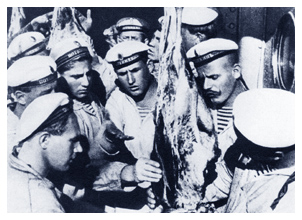 he sleep
of those off duty . . ." a sonorous hectometer. It should
be remarked that the London Film Society was concerned in the
preparation of the English titles (their mark appears behind the
main titles) with admirable results.
he sleep
of those off duty . . ." a sonorous hectometer. It should
be remarked that the London Film Society was concerned in the
preparation of the English titles (their mark appears behind the
main titles) with admirable results.
Pictorial compositions emphasizing unrest portray the sleepers in their swaying hammocks; the montage at once establishes a rhythm which rises to a peak when the petty officer strikes a new rating; the flow is shown in two short shots, but on action. At this point is introduced the leader of the man. Vakulinchuk. He is immediately established as a leader in a vigorous medium close-up. To his protesting speech the others listen in agreement; this agreement is expressed in close shots of expertly selected types each shot packed with composed action.
Next day, there is unrest on account of bad meat. This is conveyed by long shots from various angles of the indignant crowds around the meat, in each of which can be seen all or part of the captain, his pacing about uncertainly, aloft, being carried through as one continuous action; the cutting is brisk and restless. The n the decision that the meat is good is brazenly given by the surgeon lieutenant, in spite of the revolting close-up of the worms; and with a shrug he walks away.
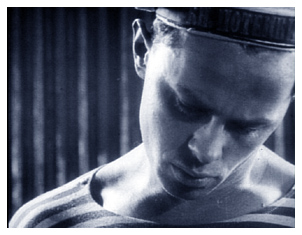 The men sullenly go about their
duties, compared with a steaming pot by a ink title, "Brimming
over . . ." As the pans are set out on the swinging tables,
the officer nods his head in time -an excellent touch of naturalistic
comedy. The refusal of the men to eat the borshch made from the
bad meat is duly reported to the captain on the bridge. Washing
the plates in the galley, a rating's pent-up fury is set off at
reading the inscription on one plate, "Give us this day our
daily bread." (Thus, ingeniously, is a piece of anti-God
propaganda inserted). The rating smashes the plate in a sequence
of text-book perfection. Thus: --
The men sullenly go about their
duties, compared with a steaming pot by a ink title, "Brimming
over . . ." As the pans are set out on the swinging tables,
the officer nods his head in time -an excellent touch of naturalistic
comedy. The refusal of the men to eat the borshch made from the
bad meat is duly reported to the captain on the bridge. Washing
the plates in the galley, a rating's pent-up fury is set off at
reading the inscription on one plate, "Give us this day our
daily bread." (Thus, ingeniously, is a piece of anti-God
propaganda inserted). The rating smashes the plate in a sequence
of text-book perfection. Thus: --
. . . having red the inscription . . .
F.C.S. (dark, lowering) the rating mutters through clenched teeth
- 30 frames
C.M.S. He grasps plate and . . . - 5 frames
C.M.S. . . . raises it above . . . - 4 frames
C.S. . . . his head and . . . - 6 frames
C.M.S. . . . brings it down . . . - 8 frames
C.S. . . . raises it aloft . . . - 6 frames
F.C.S. his exultant face . . . - 6 frames
C.M.S. he brings it down . . . - 6 frames
C.M.S. . . . smashes it on the table
------- End of reel 1 ------
The power of these final five seconds is remarkable. Apart from the dramatic force conveyed by the rapid tempo of montage with short shots, repetition of the down movement gives terrific extra emphasis.
The whole action could have been covered in one mid-shot lasting about one second (=16 frames). Instead it has been drawn out in time to about 2 _ seconds and in addition been given detailed dramatic significance. The several shots match excellently and shooting must have eaten up some 8 to 10 seconds' worth of stock, the simple and obvious answer to those ignorant armchair critics who have stupidly suggested that the Russians invented quick cutting to "use up all the bits of film, as stock was so scarce."
The second reel opens with the parade on deck, where an example is to be made of those complaining about the borshch. The sequence suffers from rambling construction which can only partly be excused on the grounds that it portrays the anxiety and indecision of the action. On one hand there are excellent pictorial compositions, and in two cases superbly cut close-up flashes; on the other there are two absurdly incorrect titles, which weakly describe action about-to-be-shown. The second is "Some tried to escape by the Admirals Hatch," followed by a long shot of the attempted escape. Tarpaulins are brought out and flung over the small group who failed to escape; the others converse agitatedly by the gun turret.
The firing party presents arms - well dramatized in several
short shots. Some of the sailors under the tarpaulin fall to their
knees. Suspense is worked up by sheer technical montage brilliance
with inter-cut detail shots of the fidgeting officer, the grotesque
priest, the impersonal battleship itself (by S.C. of a life-belt),
interspersed with the menacing rifles, the doomed sailors, and
their whispering comrades. Then Vakulinchuk shouts
TITLE (large type) "Brothers!"
C.S. he shouts (6 frames)
TITLE "Would you shoot your comrades?"
C.S. One disturbed anxious member of the firing party
M.S. The line of rifles; some waver slightly
TITLE "The rifles waver."
. . . then the order to fire is openly disobeyed and instead all the sailors procure arms and turn on the officers.
The arrangement of the quoted part of the above sequence is of special interest. The shots chosen accurately portray precisely the important details of the action. The splitting of the title giving Vakulinchuk's exhortation adds powerful emphasis, the 6-frame close-up being dynamic. This apt montage and splitting of title wording to make possible a quicker tempo through shorter shots is typical of the Russian theory, similar to the final shots of reel 1. It was (as explained openly by both Eisenstein and Pudovkin) directly developed from the work of D.W. Griffith, in particular from the inspired montage towards the end of "Intolerance" (1916).
For the Russian developments, both good and bad, D.W.G. is largely responsible. An example of the bad is found in the final, redundant title of the above quotation. It was a maddening trick of Griffith's to insert unnecessary explanatory titles; in only rare cases was the desired effect achieved. Thus in his 1919 "True Heart Susie" we find the absurdly unnecessary title, "Bettina impressed" followed by a self-explanatory close-up of Clarine Seymour as Bettina looking impressed; whereas by contrast in his 1919 "The Girl Who Stayed at Home," between mid shots at the death-bed of the father, as he struggles to say his last message, Griffith was inspired to place the title "Dim words. . ." This examples clearly illustrate the axiom that the title wording must be weaker than the action which follows. Eisenstein unfortunately failed to grasp this important distinction, and his editing construction is correspondingly weakened.
The fighting scenes are impressive, realistic, virile. Some offices are drowned. Vakulinchuk is shot, his body caught in a davit rope, whence he falls into the sea. At sundown, in a tent on the mole at Odessa, his body is laid in state . . . End of Reel 2.
At the scenes taken in the morning mist at Odessa Harbour, with which reel 3 opens, there has been leveled a profusion of enthusiastic acclaim which leaves the present writer stone cold. Pudovkin wrote:
A wonderful example (of the depiction of the environment) affording unquestionably an achievement, are the pictures of the misty dawn rising over the corpse of the murdered sail in "The Battleship Potemkin."
Pudovkin was making the point that environment can be chosen to add to the action-drama, for example, the snowstorm adding to the pathos of Lillian Gish's running away in D.W. Griffith's "Way Down East" 91920)
But this cannot be applied to the present case as the mist is gone and bright day is come before the tent on the mole is shown. Moreover, the first shot in the sequence, following the title, "Mist enwrapped the night," shows a dock crane busily at work by what is obviously sunlight, a ludicrous error. On the other hand, the shots are beautifully composed and lovely in texture, particularly a close-up of the sea surface; and while one can sympathise with Eisenstein and Tissé falling in love with them, the fact remains that they are redundant, and distracting from the main theme, and should therefore be cut.
The few first townspeople trickling towards the tent are portrayed in expertly and sincerely directed long and mid-shots. Then follows a charming sequence as people, flock to the mole, impelled by rumours indicated correctly in sub-titles set in italics. Enthusiastic sympathy for the men of the Potemkin runs high; Eisenstein with his masterly command of the montage theory runs up the effect of the rising feeling among the crowds in a vigorous crescendo, the shots decreasing to mere flashes. Two dissenters are downed. A delegate from the town informs the men on the Potemkin that the officers have gathered in the theatre with the military, but that the townspeople are on their side. Amid cheers, the red flag is hoisted (dead black, on ortho stock). In response, crowds gathered on the steps of Odessa cheer in unison . . . End of Reel 3.
Learning from the Americans in general (and again from D.W. Griffith in particular), Eisenstein is at pains to secure heightened dramatic effect in the massacre on the steps by means of contrast and of insistence on the attitude of the townspeople. The former is accomplished by showing at some length the comparatively irrelevant business of food being taken to the battleship; the latter by the opening title of the reel.
Rhythmic movement and cutting, sparkling photography, cheerful acting, are combined by Eisenstein in his editing plan with wonderful success; and are deserving of as much praise and study as the more obviously perfect steps sequence which follows. In particular, attention is drawn to the compositional purity, and shot matching; these are deeply analysed in Vladimir Nilsen's book quoted above (pages 116-119). I believe these are due to Eisenstein's unique perfection in arranging his hosts rather than to conscious organization during shooting, because I find that equivalent passages occur in American talkies, e.g., in "The Long Voyage Home" (1940, by John Ford).
Much must depend upon the cameraman's (inborn?) ability
to cover the sequence with shots which inherently match one another.
In this connection it is interesting to note the fact that Tissé
was a news-reel cameraman before he joined Eisenstein; presumably
his expressive, narrative use of the dynamic camera-angle promoted
him to his position with Eisenstein. In contrast to the subjective
power of his mid shot and long shot compositions, his close-ups
are often unimpressive, depending on the objective appeal of their
subject 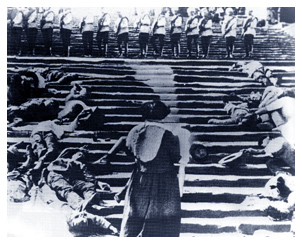 - as one might expect
from a man trained in the news-reel field.
- as one might expect
from a man trained in the news-reel field.
In contrast to the bright yawls scenes, which occupy the first 115 feet of the reel, the construction of the steps sequence depends far more on direction and cutting than on photographic artistry. By sheer perfection of his arrangement of shots, Eisenstein has created the most shattering 5 _ minutes ever put on the screen. The time factor alone is a point of interest. The descent of the steps by the lines of soldiers could, in fact, occupy no more than two minutes; and so in the course of the dramatic construction, the time factor is expanded threefold.
A title: "Suddenly" - starts the sequence, followed by flashes of a girl's head, mid shot of the feet of the crowd starting to move down, (including a legless man and culminating in the approach of a patterned parasol right up to the lens - a pointless effect), then symbolic long shot of the legless man's uneasy but rapid flight (the oppressed weak). Then in a mighty long shot looking down the steps, taken from a monument in the town with a statue commanding the foreground, the first line of soldiers appears in the bottom of the frame . . .
In a complementary wide-angle shot from the bottom, the
crowd rushes down. Then the first shot is fired; but we do not
see it . . . instead, brilliantly -
C.S. a man's knees slowly sag forwards . . . 45 frames
M.S. (pan down) a man throws out his arm . . . 9 frames
C.S. (pan down) man collapses on steps . . . 15 frames
C.S. (as first shot) knees - finish of collapse 7 frames
The second and third of these shots were probably shot as one, four or five frames being cut from the middle to heighten the impact; the effect of the steps rushing up to meet the eye of the falling man, added power being achieved by showing another falling man in the same shot. Then in long shot the man's collapse is finally concluded.
More soldiers advance; and in a spacious tracking-shot from a high level the camera covers a portion of the crowds racing wildly downwards. Detail mid shots show some taking shelter at the sides. One cynical long shot is framed in the foreground by a tree, moving softly in the sunny breeze. Then another volley is fired and one pitiful victim is a child (seen waving, earlier, with his mother). The mother pauses; looks round; and cries out in a close-up of tragic intensity; and turns back to her son.
Another woman, of head-schoolmistress type, addresses a section of the crowd . . . "Go - beseech them -" They fearfully huddle together. Shouting emotionally, the mother bears her boy up three steps. A line of soldiers stops; their shadows underline their menace; the camera tracks back till the arm of the officer appears I the frame; as she sinks to her knees they fire and she falls backwards. This is covered in four shots, for cutting emphasis.
Dramatic use is made of shadows; the sun shines down the steps and harsh contrast is achieved by means of mirror reflectors in some shots looking up the steps.
Then another volley, and another, from the inexorable lines
of soldiers; and below, mounted Cossacks charge through those
who are escaping . . . And then comes the final tragic episode,
as a young mother is caught with her pram on the steps; in mid
shot she frantically leans over and kisses the baby, then turns
round; a close-up flashes her fear; in mid shot she stands braced,
shielding the pram; a cut-in close-up shows the baby, disturbed.
Then . . .
L.S. (feet only) A line of soldiers halts and . . . 51 frames
L.S. (looking along line of rifles) . . . fires 22 frames
FC.S. The mother cries out and 17 frames
FC.S. her head sways backwards; 23 frames
C.S. the pram wheels hover at the top step; 30 frames
FC.S. her head sways forwards; 54 frames
FC.S. her hands clutch at her chest. 21 frames
L.S. Massacre at foot of steps continues. 67 frames
FC.S. Her hands. Her fingers are covered with blood; 35 frames
FC.S her eyes close. Her head sinks out of the frame 84 frames
CM.S. She sinks down against pram. 42 frames
L.S. A line of soldiers proceeds away down the steps 28 frames
M.S. Baby in pram; 49 frames
C.S. pram wheels hover on top step 15 frames
L.S. (feet only) A line of soldiers advances 30 frames
L.S. (along rifles) they advance . . . 28 frames
M.S. The mother strives to move forward, but . . . 24 frames
M.S. . . . sinks back against the pram . . . 27 frames
C.S. Pram wheels move . . . 16 frames
M.S. Mother sinks right back, helplessly . . . 11 frames
M.S. (tracking) Pram jolts down steps; 45 frames
CM.S. pram moves forward; 17 frames
C.S. pram wheel moves as mother's head falls against it; 14 frames
C.S. wheel moves on; 7 frames
C.S. the schoolmistress shouts in horror 8 frames
And the pram jolts down, miraculously straight down the idle,
shown in numerous shots till it reaches the bottom and tips grotesquely
over, an unforgettable symbol of innocence caught in the chaos
of horror.
Particularly noteworthy in the above quoted extract is the way the time factor has been spun out; the emphasis, also, due to repetition, the pushing away of the pram being shown twice; the jumbled-up shot lengths which cause an emotional confusion as opposed to the precise rhythm of cutting to a pattern of related lengths.
The revenge is shown symbolically. A slowly-turning gun
turret represents the ship, a group of statues the military H.Q.
One shot is fired, an explosion is shown; then come three 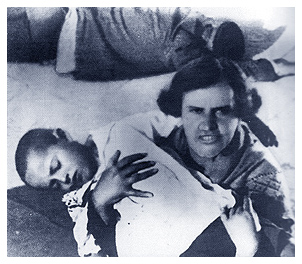 short shots - a stone lion sleeping,
a lion with open eyes, and a lion rampant; then another explosion.
End of reel 4.
short shots - a stone lion sleeping,
a lion with open eyes, and a lion rampant; then another explosion.
End of reel 4.
The purely cinematic symbol of he lion jumping to life is a brilliant conception, stressing the battleships power. As a matter of interest neither the lions, the explosions, nor the group of statues were shot at Odessa; but at such diverse places as Livadea in the Crimea and at Moscow - a fine example of how geographical relationships are established in film editing.
After the steps sequence, the fifth and last reel inevitably comes as an anticlimax; particularly as it is perfectly obvious that the rebel ship will be acclaimed (though here the highbrows praised the suspense, whereas they scorned the equally cinematic suspense of an American melodrama whose happy ending was actually not one whit more obvious). Furthermore, Eisenstein has slightly erred with over-emphasis in his desperate attempt to infuse the maximum of suspense during the night and the maximum of jubilation at the reception by the rest of the fleet.
The reel opens with a vigorously presented mass meeting aboard the ship, which resolves to meet the fleet. Night is then indicated by finely composed sky shots of which, however, one is spoiled by an obviously day-time sky and the other by trees, ludicrous in a sea scene and a careless error. Those on watch are dramatically portrayed. One shot of lights in the black waters of the sea is unique and fascinating. There is some unconscious humour and some continuity confusion at the daybreak. Then the fleet is sighted and action stations are manned. Detail shots of manned guns, engine pistons, the wake and he smoke trail are intercut with long shots of the threatening guns. The J-O-I-N U-S signal is hoisted, all cheer, and the Potemkin sails through. In the last shot the bows approach right up to the camera making a natural fade.
Such is the stuff of this remarkable and famous picture.
Of the brilliant musical score written for the film by Edmund Meisel, the best praise lies in recounting that the film was passed by the German censors only on condition that this accompaniment was not used. Another famous score by Meisel was for Ruttmann's impressionistic "Berlin."
Turning once more to the mechanics of the production, one cannot but feel that Eisenstein realised he had something superlative in his conception of the Odessa Steps sequence, and accordingly went to all lengths to pass on this unique creative inspiration. The elaborate trolley specially built (its shadow can be seen in one tracking shot) the reflector set-ups, the absolute perfection of the acting types chosen, the very skills in the realisation that elementary continuity requirements would fade into insignificance in the protracted time factor - these points all go to prove ah Eisenstein was indeed swayed by the immensity of this inspiration from the basic plan of the originally conceived film. And just as the Steps sequence is undoubtedly the measure of Potemkin's fame, so Eisenstein merits the crown of genius for this achievement.